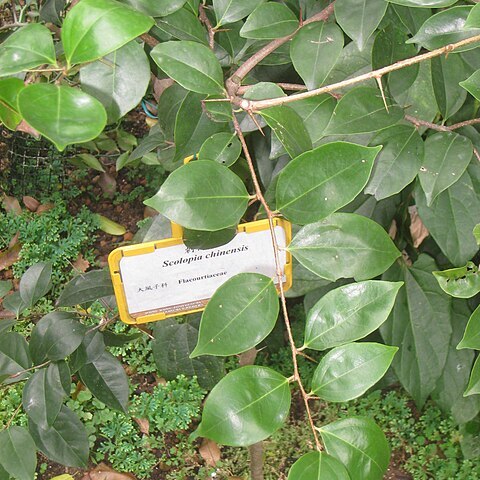Shrubs or small trees, evergreen, 2-6 m tall; bark grayish; twig tips puberulous (viewed at × 20 mag.), branchlets glabrous, branches and branchlets often spiny; spines simple, 1-5 cm. Petiole short, 3-5 mm, puberulous; leaf blade elliptic to oblong-elliptic, 4-7 × 2-4 cm, leathery, both surfaces glabrous, lateral veins 4-6 pairs, slender, basal 1 or 2 pairs high ascending, reticulate veins clear on both surfaces (at × 10 mag. or less), not sparse, base broadly acute to subrounded, margin entire to serrulate, with a pair of glands at junction of blade and petiole, glands much larger than those elsewhere on margin, apex broadly acute to rounded, tip apiculate or with a very short blunt acumen 1-2 mm. Racemes axillary or terminal, 2-6 cm, puberulous. Pedicels 4-10 mm, puberulous. Flowers yellowish, ca. 4 mm in diam. Sepals 4 or 5(-7), ovate-triangular, 1-1.5 mm, abaxially pubescent, margin ciliate. Petals obovate-oblong, 1.5-2 mm, to 1.5 × as long as sepals, outside sparsely pubescent to subglabrous, margin ciliate. Disk glands 10, fleshy. Stamens ca. 5 mm; anthers globose, connective with conspicuous appendage at apex, appendage ca. as long as connective, usually with 1 to few hairs at tip. Ovary ovoid; placentas 2 or 3, each with 2 pendulous ovules; style ca. 2 mm in young flowers, soon to 5 mm; stigma minutely lobed. Berry brownish red, dark purple, or black, orbicular-globose, (5-)8-10 mm in diam. Seeds (2-)4-6. Fl. Jun-Sep, fr. Oct-Apr of following year.
More
Small tree 4-5 m, or mostly shrub 1-2 m; branches and branchlets usually with strong, simple spines 1-5 cm. Leaves widely cuneate or nearly rounded at the base, coriaceous, glabrous, shining above, dull beneath, 3-7(-10) by 2-4½ cm, entire or nearly so, rarely serrate; petiole 3-5(-8) mm. Racemes 2-3(-6) cm, few-flowered, often ± panicled at the tops of the branches. Pedicels 4-5(-10) mm. Sepals ovate, yellowish-white, ± 2 mm, dorsally somewhat tomentose. Petals nearly glabrous, yellowish-white, 2.5-3 mm. Berry 8-10 mm.
An evergreen shrub or small tree. It grows 2-6 m tall. The small branches can often have spines. The leaves are oblong and 4-7 cm long by 2-4 cm wide. The flowers are yellowish. The fruit are brown to red or dark purple. They are round and 5-10 mm across. There are 4-6 seeds.

